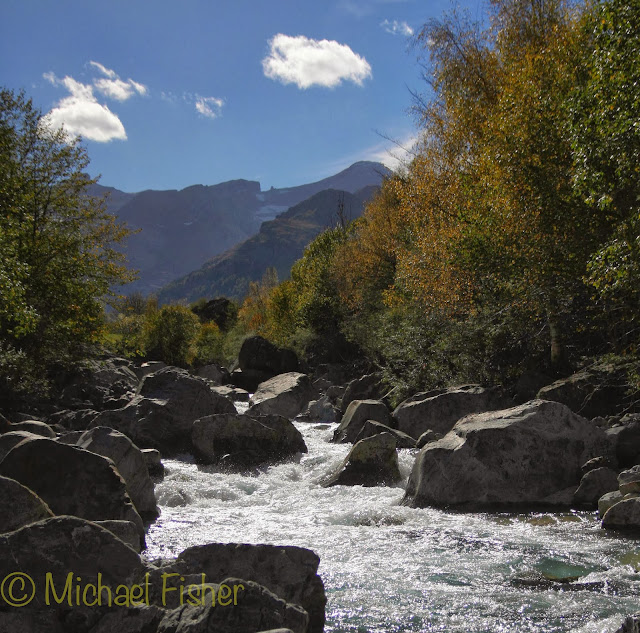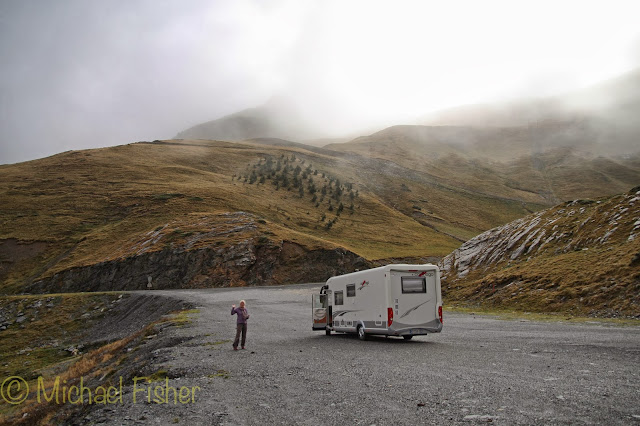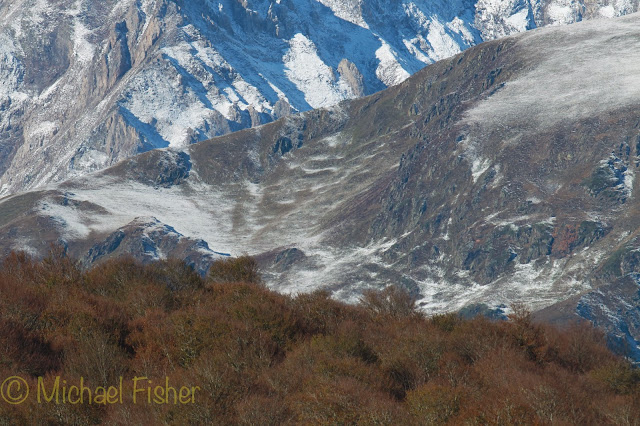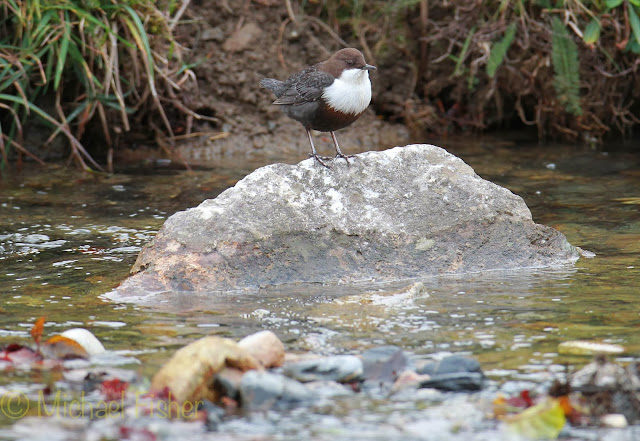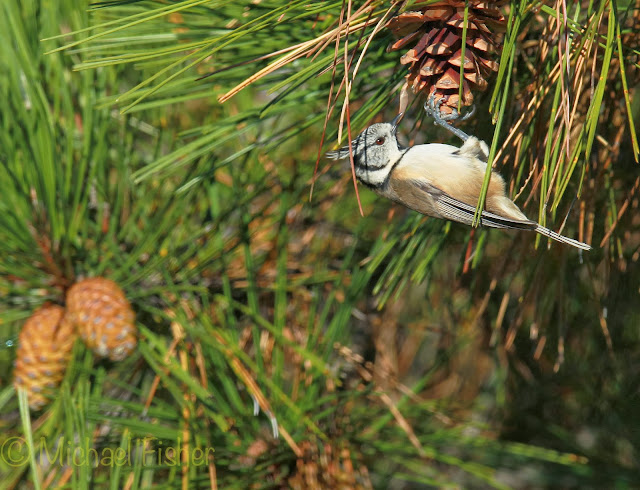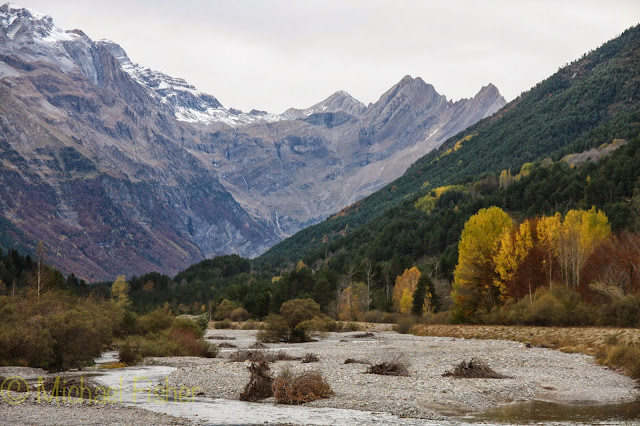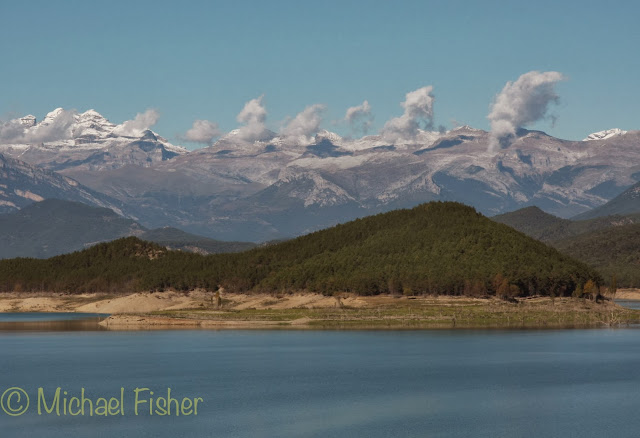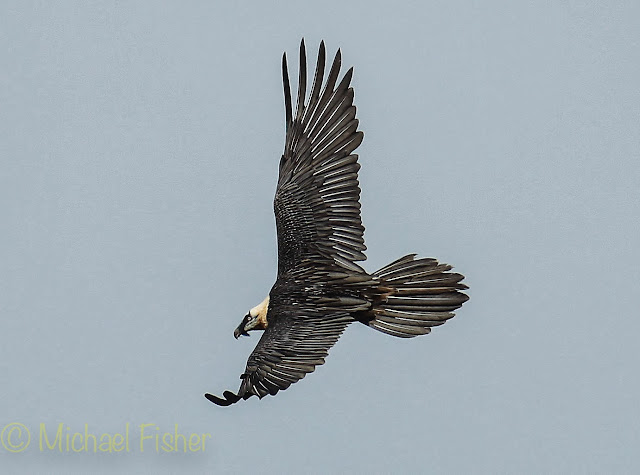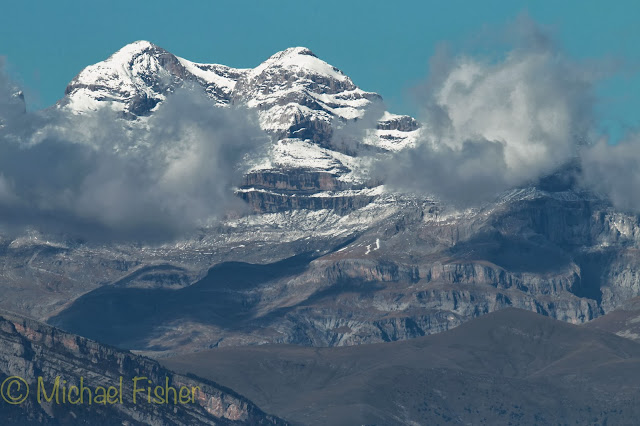Following our memorable time in the high Pyrenees with the wonderful Lammergeier Vultures, the weather threw rain, sleet, and snow at us. We had spent time exploring Ainsa before continuing across the mountain passes, sometimes shrouded in freezing clouds that even filled the valleys below us.

Our route had taken us through and around remote villages and stunning panoramas.
Autumnal colours.


We had watched Blue rock Thrush and rock buntings, and dippers were seen in the fast-flowing stream below us. We then paused, drinking a welcome coffee, watching a lone Lammergeier soar along the peaks.
The col de Portalet can be quite bleak. That morning, with frozen rain driving into our faces, we took in the rugged landscape. The distant sound of water splashing over the rocks and the occasional eerie cry of a bird engulfed us in a deep sense of solitude. One felt dwarfed in the vast space, with its towering snowy peaks.
Back in the province of Navarra and having left the mountains behind us, we stopped at Lumbier, not to walk the ancient railway line through the narrow gorge we had enjoyed many times before. That day, we intended to visit the vulture feeding station just outside the town.


Their stomach acid is so corrosive it allows them to digest flesh from putrid carcasses that can contain Botulinum toxin, even Anthrax (wool-sorters disease).
They rely on a soaring flight and have been found at altitudes as high as 32,800feet 10,000 mtrs,
but can also glide low over the ground when taking off or landing.
In 1980, there were around 1000 Griffons left in Spain; today, there are tens of thousands.
Some are migratory, overwintering in Africa, whilst others are resident and nomadic.
Many people believe that their bald heads are so because of their feeding habits and all the blood and gore. This has been researched; in fact, it is found to be for keeping their heads at a stable temperature.
They were getting quite close to us as we enjoyed our ham sandwiches!
We were hopeful they didn't like mustard, even if it was Dijon!
We made our next stop, just to the north of the Bardenas Reales, at Laguna de Pitilas,
a favourite birding site for us.
The light and clouds over the Laguna were beautiful.
Out on the Laguna, there were good numbers of migratory birds. These included waders like Ruff in large numbers, ducks, Red Crested Pochard, Pochard, and Gadwall, and migrating Greylag Geese.
Then, echoing across the hills came the deep, trilling calls of large numbers of Common Cranes. They, like us, had just crossed the Pyrenees; we could see how weary these birds were on their migration south. They would probably have been aiming for the Laguna de Gallacanta, south of Zaragosa,
but needed to land and rest.
http://roadrunnersmikelinda.blogspot.fr/2014/03/the-road-to-gallocanta.html
Many more Cranes passed over, sometimes in small family groups.
We also rested close by, falling asleep to their cries in the night.
We watched thousands of wintering Starlings head to their roost that evening.
The following day, the Cranes were still passing overhead as we made our way out onto the Bardenas Reales. These days, with modern irrigation systems, the landscape is starting to change; green fields are appearing virtually overnight in the desert terrain.
The Bardenas Reales is a semi-desert or bad land covering forty-two thousand hectares.
It is a classified UNESCO biosphere reserve.
There are enclaves of Mediterranean landscape and Aleppo pines.
It was in one of these areas that we searched for bird life.
Among some trees, we found a small flock of Goldcrests that were probably overwintering.
It's not a great photo, but it is good to see a Blue throat skulking in the rushes surrounding a small pond.
There was no need to disturb such a beautiful bird; it was probably heading further South in Spain or into Portugal!
The Bardenas Reales has beautiful colours, including ochres, blacks, greys, and browns. The light sand and gypsum reflect incredible light. However, the heat haze, even in November, makes distant photography difficult.
The Cabezon de Castildetiera.
The landscape is full of isolated hills called Cabezos, made up of clay, chalk, and sandstone. Wind and rain have eroded and shaped what we see today. This area is named the Bárdena Blanca due to the abundant salt, which gives it a white hue.
The distant view across Reso Javielo, a patchwork of seasonal streams across the area, was dry.
Millions of years ago, the basin opened to the Mediterranean Sea, and it drained, leaving the rich, deep sediments that are today farmed.
Clouds of gypsum dust followed the modern agriculture machinery.
While another vista showed a more ancient way of life.
In that vast area, sounds travelled a long distance, and we heard a noise getting louder and louder, as were the massive grey shapes that got closer.
Seeming to rise out of the distant sand came the C-17s, transporting the American 82nd Airborne Division.
Seven of these vast planes flew over us; the roar of their engines was deafening.
Far in the distance, they turned and disgorged their contents.
From our position on the Bardenas Reales, we could make out the distant gunnery range, where Czech and Spanish jets fired their cannons. Explosions filled the air.
Cougar attack helicopters swept low over us.
Don't Shoot!
It was an unusual end to our day. As the sun descended, we watched a Spanish Air Force F-18 prepare for landing at Zaragoza Airbase. In the far distance, we could see the snow-capped peaks of the Pyrenees, where we had watched Lammergeier Vultures!
That evening, as we drove towards Tudela, we had to stop and photograph the sun setting,
the sun and colours portraying the Spanish flag.
On the other side of the Bardenas Reales, the moon had started to rise.
We have many memories of birds, both feathered and metal!

Our route had taken us through and around remote villages and stunning panoramas.
Autumnal colours.


Rivers of Glacial waters and houses built off the rock.
We climbed high to the border crossing from Navarra into France, at the col Portalet, then spent that night in the Valle Pic de Midi d'Ossau in France. Driving back the following morning to the
col Portalet.
We had watched Blue rock Thrush and rock buntings, and dippers were seen in the fast-flowing stream below us. We then paused, drinking a welcome coffee, watching a lone Lammergeier soar along the peaks.
The col de Portalet can be quite bleak. That morning, with frozen rain driving into our faces, we took in the rugged landscape. The distant sound of water splashing over the rocks and the occasional eerie cry of a bird engulfed us in a deep sense of solitude. One felt dwarfed in the vast space, with its towering snowy peaks.
Back in the province of Navarra and having left the mountains behind us, we stopped at Lumbier, not to walk the ancient railway line through the narrow gorge we had enjoyed many times before. That day, we intended to visit the vulture feeding station just outside the town.

As we neared the feeding station, the hillsides were alive with Griffon vultures, resembling spectators at a football game, known in vulture terms as a "wake". The Griffons were watching the comings and goings from the carcass. These vultures may have eaten; if the crop is complete, they will sit sleepy, even half torpid, to digest the food.
Griffon vultures are joined by Ravens and Red Kites in a frenzy of feeding.
We could hear the grunts and hisses as they squabbled over the carcass, a sound that was also heard at their nesting sites.
Feeding stations like this have been set up across Spain since the BSE crisis (mad cow disease) among stock herds across Europe. Throughout Spain, carcasses were left out on the land for the Vultures and other predators to clear up. Farmers are now prohibited from this practice.
The vultures rarely take healthy stock; they are usually the sick and wounded they predate upon.

They are excellent scavengers, especially in hot regions like Spain.
Their stomach acid is so corrosive it allows them to digest flesh from putrid carcasses that can contain Botulinum toxin, even Anthrax (wool-sorters disease).
They rely on a soaring flight and have been found at altitudes as high as 32,800feet 10,000 mtrs,
but can also glide low over the ground when taking off or landing.
In 1980, there were around 1000 Griffons left in Spain; today, there are tens of thousands.
Some are migratory, overwintering in Africa, whilst others are resident and nomadic.
Many people believe that their bald heads are so because of their feeding habits and all the blood and gore. This has been researched; in fact, it is found to be for keeping their heads at a stable temperature.
They were getting quite close to us as we enjoyed our ham sandwiches!
We were hopeful they didn't like mustard, even if it was Dijon!
We made our next stop, just to the north of the Bardenas Reales, at Laguna de Pitilas,
a favourite birding site for us.
The light and clouds over the Laguna were beautiful.
Out on the Laguna, there were good numbers of migratory birds. These included waders like Ruff in large numbers, ducks, Red Crested Pochard, Pochard, and Gadwall, and migrating Greylag Geese.
Then, echoing across the hills came the deep, trilling calls of large numbers of Common Cranes. They, like us, had just crossed the Pyrenees; we could see how weary these birds were on their migration south. They would probably have been aiming for the Laguna de Gallacanta, south of Zaragosa,
but needed to land and rest.
http://roadrunnersmikelinda.blogspot.fr/2014/03/the-road-to-gallocanta.html
Many more Cranes passed over, sometimes in small family groups.
We also rested close by, falling asleep to their cries in the night.
We watched thousands of wintering Starlings head to their roost that evening.
The following day, the Cranes were still passing overhead as we made our way out onto the Bardenas Reales. These days, with modern irrigation systems, the landscape is starting to change; green fields are appearing virtually overnight in the desert terrain.
The Bardenas Reales is a semi-desert or bad land covering forty-two thousand hectares.
It is a classified UNESCO biosphere reserve.
There are enclaves of Mediterranean landscape and Aleppo pines.
It was in one of these areas that we searched for bird life.
Among some trees, we found a small flock of Goldcrests that were probably overwintering.
It's not a great photo, but it is good to see a Blue throat skulking in the rushes surrounding a small pond.
There was no need to disturb such a beautiful bird; it was probably heading further South in Spain or into Portugal!
The Bardenas Reales has beautiful colours, including ochres, blacks, greys, and browns. The light sand and gypsum reflect incredible light. However, the heat haze, even in November, makes distant photography difficult.
The Cabezon de Castildetiera.
The landscape is full of isolated hills called Cabezos, made up of clay, chalk, and sandstone. Wind and rain have eroded and shaped what we see today. This area is named the Bárdena Blanca due to the abundant salt, which gives it a white hue.
The distant view across Reso Javielo, a patchwork of seasonal streams across the area, was dry.
Millions of years ago, the basin opened to the Mediterranean Sea, and it drained, leaving the rich, deep sediments that are today farmed.
Clouds of gypsum dust followed the modern agriculture machinery.
While another vista showed a more ancient way of life.
In that vast area, sounds travelled a long distance, and we heard a noise getting louder and louder, as were the massive grey shapes that got closer.
Seeming to rise out of the distant sand came the C-17s, transporting the American 82nd Airborne Division.
Seven of these vast planes flew over us; the roar of their engines was deafening.
Far in the distance, they turned and disgorged their contents.
Apparently, we were in the middle of Trident Juncture, NATO's most extensive training exercise in many years.
On the 4th of November, they dropped 650 paratroopers from Fort Bragg in America onto the Zaragoza training area.
From our position on the Bardenas Reales, we could make out the distant gunnery range, where Czech and Spanish jets fired their cannons. Explosions filled the air.
Cougar attack helicopters swept low over us.
Don't Shoot!
It was an unusual end to our day. As the sun descended, we watched a Spanish Air Force F-18 prepare for landing at Zaragoza Airbase. In the far distance, we could see the snow-capped peaks of the Pyrenees, where we had watched Lammergeier Vultures!
That evening, as we drove towards Tudela, we had to stop and photograph the sun setting,
the sun and colours portraying the Spanish flag.
On the other side of the Bardenas Reales, the moon had started to rise.
We have many memories of birds, both feathered and metal!
Happy Days!

































